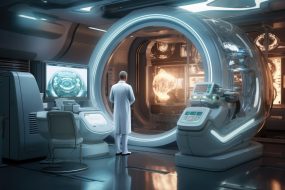- Home
- Technology & AI
- HHS Leaders Outline Plans to A ...

HHS Leaders at the U.S. Department of Health and Human Services (HHS) are emphasizing the role of artificial intelligence (AI) and data interoperability in improving patient care and making the healthcare system more efficient. The Trump administration has expressed its intent to accelerate the deployment of AI-driven tools and expand access to health data.
Amy Gleason, acting administrator of the U.S. Digital Operations Government Service and strategic advisor at the Centers for Medicare & Medicaid Services (CMS), said the government’s role should focus on establishing infrastructure while allowing private industry to innovate.
In late July, CMS launched the Health Technology Ecosystem Initiative and Interoperability Pledge. The agency’s priorities include building an interoperability framework and supporting the use of personalized digital health tools. CMS also plans to establish an app store featuring approved health applications, integrate AI-based chatbots to improve access to healthcare information, and require applications to use modern identity systems.
Gleason said empowering patients, physicians, and payers with better access to data can help reduce costs. She added that her interest in healthcare technology was influenced by her personal experience navigating her daughter’s treatment for a rare autoimmune condition, which involved multiple specialists and health systems. Gleason said she believes broader data sharing and modern AI could have accelerated her daughter’s diagnosis and continues to see AI tools as valuable in managing chronic illness.
Sixty companies have joined the Health Technology Ecosystem Initiative and are expected to demonstrate results by the first quarter of 2026. Gleason said the program will introduce new goals every six months.
As part of broader efforts to improve infrastructure, CMS is developing a national provider directory using FHIR-based APIs and adding modern digital identity features to Medicare.gov. Gleason said these projects illustrate how government can create foundational systems while private companies build applications on top of them. She noted that CMS is consolidating data from eight provider databases into one source to improve accuracy and reduce duplication across the industry.
The CMS is also expanding its internal technical capabilities. Gleason stated that when she joined the agency, there were only 12 engineers compared to thousands of contractors. She said the agency is now recruiting experienced technology professionals from both large companies and startups for short-term government service roles.
An HHS official said that the department is also hiring AI and data specialists across its divisions, including the Centers for Disease Control and Prevention (CDC).
The official added that HHS deployed a large language model to its 60,000 employees in September, with thousands using it weekly for tasks such as summarizing research papers, and that the agency aims to expand AI use internally while ensuring it benefits providers and patients.
HHS Leaders Drive the Push for AI & Data Sharing
The U.S. Department of Health and Human Services (HHS) Leaders have laid out an ambitious agenda to integrate artificial intelligence (AI) and enhance data sharing across the U.S. healthcare system. This effort is aimed at modernizing care delivery, improving patient access to health information, and strengthening interoperability of health systems.
Key Focus Areas of the HHS Leaders’ Strategy
-
Accelerating AI innovation and deployment: The HHS Leaders emphasise using AI to automate administrative tasks, improve diagnostics, personalise treatment plans and detect public-health trends. Healthcare Dive+2AAMC+2
-
Promoting ethical, responsible AI: The HHS Leaders’ roadmap highlights the importance of fairness, transparency, bias mitigation, data privacy and accountability in AI systems. Certifi+1
-
Advancing data sharing and interoperability: The HHS Leaders are advancing frameworks to allow patient access to their data, enable structured/unstructured data exchange, and support networks meeting interoperability criteria. himss.org+2Bloomberg+2
-
Building the workforce and infrastructure: The HHS Leaders plan to develop AI-ready talent, strengthen digital infrastructure and support underserved providers through regional technical assistance centres. Healthcare Dive
Why This Matters
With healthcare costs rising and workforce pressures increasing, the HHS Leaders’ push for AI and data sharing comes at a critical time. By enabling secure, seamless data access and automating back-office functions, the strategy aims to relieve burdens on providers and improve patient care quality. Moreover, by emphasising equity and interoperability, the HHS Leaders hope to narrow the digital divide between large systems and under-resourced providers.
Challenges & Considerations
The HHS Leaders recognise multiple challenges:
-
Ensuring AI systems are accurate, do not perpetuate bias and are transparent in how they make decisions. ACA Today+1
-
Protecting patient privacy and cybersecurity, especially as data flows increase. Healthcare Dive+1
-
Ensuring the infrastructure exists across all healthcare providers (large and small) to implement AI and data-sharing initiatives.
-
Keeping pace with evolving technology while maintaining regulatory oversight.
What’s Next for HHS Leaders
The HHS Leaders plan to release additional guidance, pilot programmes, and support tools in the coming years. Key next steps include publishing an updated inventory of AI use-cases, releasing voluntary certification frameworks for AI in healthcare, advancing the national interoperability framework and expanding public-private partnership.







